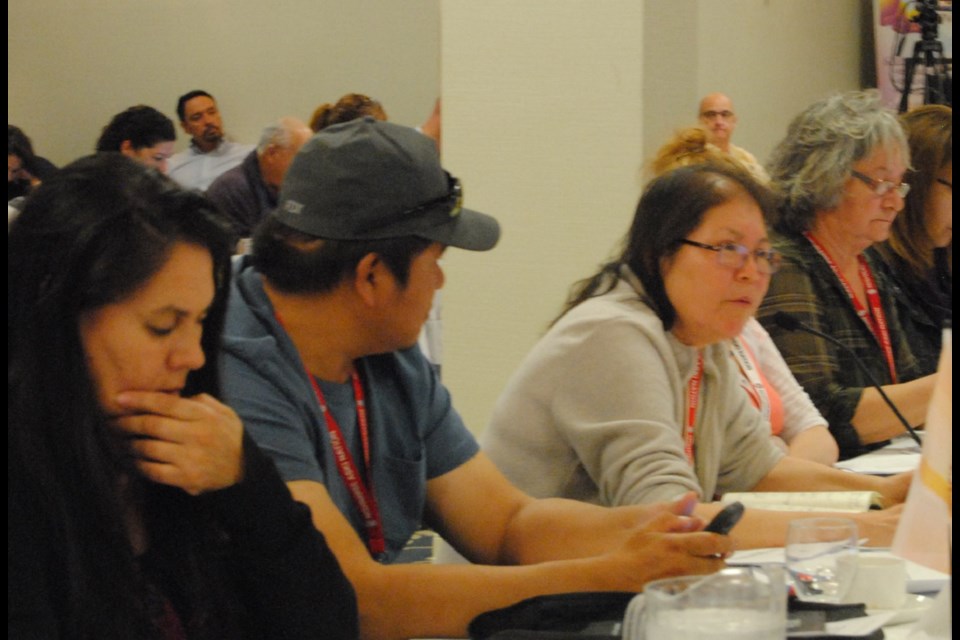During last Thursday’s Nishnawbe Aski Nation (NAN) session with Aboriginal Affairs Minister David Zimmer, the minister had just weathered a blistering criticism from Jonathan Solomon, Grand Chief of Mushkegowuk Council over the Wynne government’s failure to live up to its own pledge to consult First Nations on important legislation when Chief Marcia Brown Martel of the Beaverhouse First Nations spoke up about the failure of a string of Ontario governments to provide a land base.
“Why after 110 years of promise to provide a land base have the federal and provincial government not acted to provide a land settlement for my people,” Chief Brown Martel asked Minister Zimmer.
The traditional lands of the Beaverhouse First Nation are located near Kirkland Lake, Ontario.
“I welcome the Minister,” Brown Martel said. “I was taught that when we invite people we must play nice.
“Sunday afternoon BBQ rules,” she added. “Other than my heart and my emotions and thoughts are not there – but I will play nice.”
“Beaverhouse is one of the First Nations that do not have land mass even though treaties were signed in 1905," she explained.” One question I would like to ask you is why are we dealing with no land?
“We are the indigenous people of our territory and yet we have no land to live on despite treaties."
“Which means there are no infrastructures in my community, there is no running water there is no power source, it’s stepping back 200 years,” she explained.
Chief Brown Martel noted the irony that people of Beaverhouse are in a position where they now are squatters, a Canadian legal term meaning one is occupying lands that aren’t theirs though they are on lands that have been their traditional homelands.
“There is something wrong with that,” Chief Brown Martel emphasized.
“It is about time that we got our land mass — we need a place to live,” she said. ”Resources are being taken from the land all over since the signing of the 1905 treaty.
The signing of Treaty 9 in 1905 occurred during the massive silver boom in Cobalt, Ontario and preceded the gold rushes in Larder Lake, Kirkland Lake and the Timmins-Porcupine area.
But inexplicably the people of the Beaverhouse First Nation were not recognized under the treaty.
“It’s kind of strange that you found the gold then, but didn’t see the people, and the problem is 111 years later we are still invisible," she said, “but we are here, we are always going to be here.”
Zimmer thanked Chief Brown Martel and pledged to help.
“I will do three things,” Minister Zimmer pledged. “I will speak to my deputy minister both about the compensation process and the land mass process and I will raise this with Minister Bennett (Carolyn Bennett, federal minister of Indian and Northern Affairs)."
In his introductory remarks Zimmer identified his top priorities as:
Providing clean drinking water
Working to solve the tragedy of youth suicides
Developing a northern health strategy
Bringing permanent electricity services to remote communities.
“Canada and Ontario have a reputation for having the largest source of fresh water in the world and yet we have drinking water problems. This is obscene,” he said.
“The technology of water treatment is changing rapidly and some of the old technology is old and clunky, but today it is simple and uncomplicated and low cost technology,” he explained.
Zimmer said he is very concerned about the spate of youth suicides. While visiting a northern reserve Zimmer met a group of young people. Later when news of suicides on the reserves reached him he said he wondered if some of the suicides involved the youth he had met.
“How can we let this situation go on?” he asked.
Zimmer said he recognizes the challenge of bringing a health care strategy to the northern remote communities, but it is desperately needed. He said communities well be consulted in the next little while.
“Both Ontario Health Minister Eric Hoskins and Carolyn Bennet the Federal Minister of Indian and Northern Affairs are medical doctors and they are talking about these issues all the time,” Zimmer said.
On economic issues Zimmer said the Wynne government has a remote electrification readiness program to help hook First Nations to the grid, but at least one Port Severn First Nation is too far to hook up he acknowledged.



